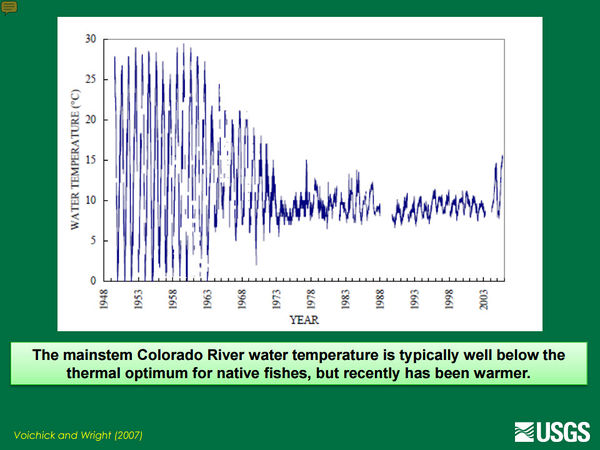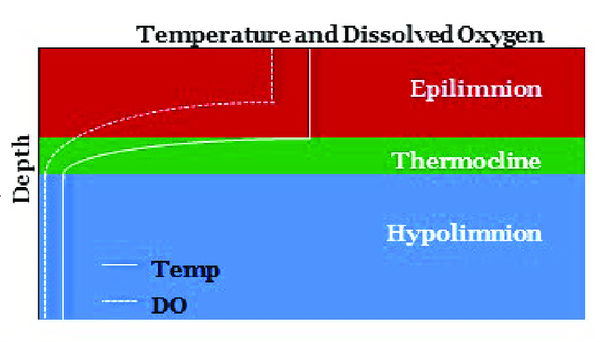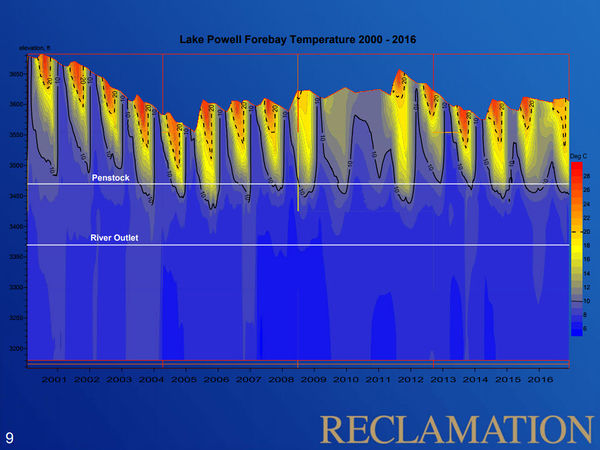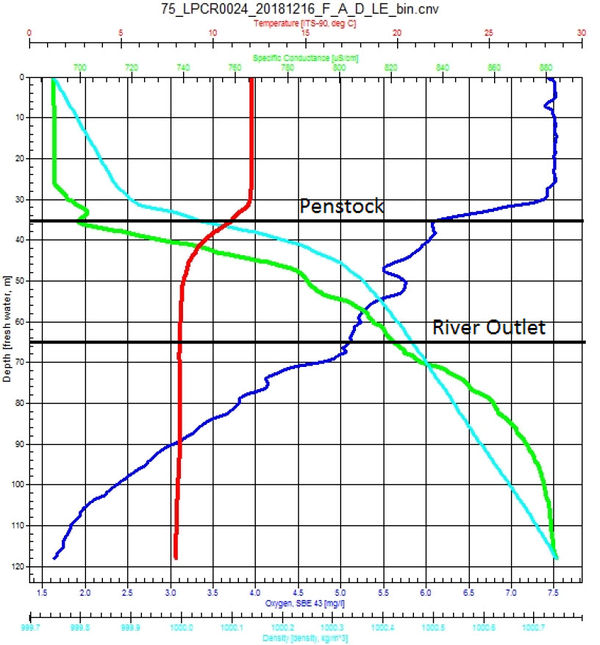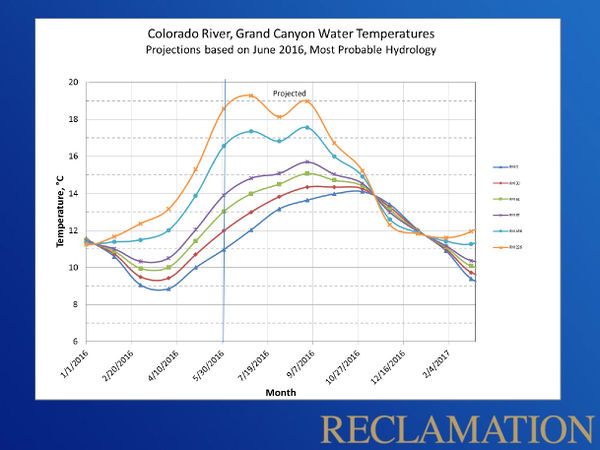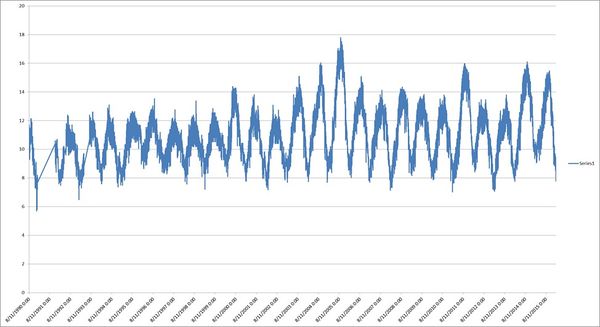Difference between revisions of "TEMPERATURE"
Cellsworth (Talk | contribs) |
Cellsworth (Talk | contribs) |
||
| Line 125: | Line 125: | ||
*[https://www.usbr.gov/uc/progact/amp/twg/2018-10-10-twg-meeting/Attach_01.pdf Temperature Control Device Update PPT] | *[https://www.usbr.gov/uc/progact/amp/twg/2018-10-10-twg-meeting/Attach_01.pdf Temperature Control Device Update PPT] | ||
*[https://doi.org/10.1007/s10641-018-0774-7 Dibble et al., 2018, Warm water temperatures and shifts in seasonality increase trout recruitment but only moderately decrease adult size in western North American tailwaters: Environmental Biology of Fishes] | *[https://doi.org/10.1007/s10641-018-0774-7 Dibble et al., 2018, Warm water temperatures and shifts in seasonality increase trout recruitment but only moderately decrease adult size in western North American tailwaters: Environmental Biology of Fishes] | ||
| − | *[https://www.usbr.gov/uc/ | + | *[https://www.usbr.gov/uc/progact/amp/twg/2018-01-25-twg-meeting/AR11.pdf Temperature and nutrients as ecosystem drivers in the Colorado River PPT, Lake Powell as a regulator of temperature and Lake Powell as a regulator of nutrients PPT] |
'''2017''' | '''2017''' | ||
| − | *[https://www.usbr.gov/uc/ | + | *[https://www.usbr.gov/uc/progact/amp/twg/2017-01-26-twg-meeting/AR4_Radtke.pdf Water Quality in Lake Powell and Its Influence on the Colorado River Below Glen Canyon Dam PPT] |
*[https://digitalcommons.usu.edu/cgi/viewcontent.cgi?article=1951&context=wats_facpub Pine et al. 2017. Growth of Endangered Humpback Chub in Relation to Temperature and Discharge in the Lower Colorado River. USU Watershed Sciences Faculty Publications] | *[https://digitalcommons.usu.edu/cgi/viewcontent.cgi?article=1951&context=wats_facpub Pine et al. 2017. Growth of Endangered Humpback Chub in Relation to Temperature and Discharge in the Lower Colorado River. USU Watershed Sciences Faculty Publications] | ||
| Line 147: | Line 147: | ||
'''2010''' | '''2010''' | ||
| − | + | *[https://www.usbr.gov/uc/progact/amp/twg/2010-11-15-twg-meeting/Attach_13.pdf Incorporating thermal regimes into environmental flows assessments: modifying dam operations to restore freshwater ecosystem integrity by Julian D. Olden and Robert J. Naiman (University of Washington, Seattle)] | |
| − | *[https://www.usbr.gov/uc/ | + | *[https://www.usbr.gov/uc/progact/amp/amwg/2010-08-24-amwg-meeting/Attach_12a.pdf Selective withdrawal and sediment augmentation update] |
| − | *[https://www.usbr.gov/uc/ | + | *[https://www.usbr.gov/uc/progact/amp/amwg/2010-08-24-amwg-meeting/Attach_12a.pdf Temperature Control Device and Sediment Augmentation Report] |
| − | *[https://www.usbr.gov/uc/ | + | *[https://www.usbr.gov/uc/progact/amp/amwg/2010-08-24-amwg-meeting/Attach_12b.pdf TWG Chair Temperature Control Device/Sediment Augmentation] |
| − | *[https://www.usbr.gov/uc/ | + | *[https://www.usbr.gov/uc/progact/amp/twg/2010-03-15-twg-meeting/Attach_07.pdf Sediment and Temperature Modeling Update PPT as presented at January 2010 Annual Reporting Meeting] |
| − | *[https://www.usbr.gov/uc/ | + | *[https://www.usbr.gov/uc/progact/amp/twg/2010-01-21-twg-meeting/Attach_07.pdf Temperature Control Device and Sediment Augmentation and PPT] |
'''2009''' | '''2009''' | ||
| − | *[https://www.usbr.gov/uc/ | + | *[https://www.usbr.gov/uc/progact/amp/twg/2009-09-29-twg-meeting/Attach_14.pdf Selective Withdrawal and Sediment Augmentation Update PPT] |
| − | *[https://www.usbr.gov/uc/ | + | *[https://www.usbr.gov/uc/progact/amp/twg/2009-09-29-twg-meeting/Attach_06.pdf Grand Canyon Monitoring and Research Center Updates] |
| − | *[https://www.usbr.gov/uc/ | + | *[https://www.usbr.gov/uc/progact/amp/amwg/2009-04-29-amwg-meeting/Attach_03a.pdf Grand Canyon Monitoring and Research Center (GCMRC) Update] |
'''2008''' | '''2008''' | ||
*[https://www.usbr.gov/tsc/techreferences/hydraulics_lab/pubs/PAP/PAP-0972.pdf The Glen Canyon Dam temperature control device: restoring downstream habitat for endangered fish recovery] | *[https://www.usbr.gov/tsc/techreferences/hydraulics_lab/pubs/PAP/PAP-0972.pdf The Glen Canyon Dam temperature control device: restoring downstream habitat for endangered fish recovery] | ||
| + | *[https://www.usbr.gov/uc/progact/amp/twg/2008-04-08-twg-meeting/Attach_05g.pdf Anderson and Wright. 2007. Development and application of a water temperature model for the Colorado River below Glen Canyon Dam, Arizona. Hydrological Science and Technology, V 23, No 1-4. ] | ||
'''2007''' | '''2007''' | ||
*[http://www.riversimulator.org/Resources/USBR/LTEP/ValdezTCDra2007.pdf Valdez and Speas. 2007. A Risk Assessment Model To Evaluate Risks and Benefits to Aquatic Resources From A Selective Withdrawal Structure On Glen Canyon Dam ] | *[http://www.riversimulator.org/Resources/USBR/LTEP/ValdezTCDra2007.pdf Valdez and Speas. 2007. A Risk Assessment Model To Evaluate Risks and Benefits to Aquatic Resources From A Selective Withdrawal Structure On Glen Canyon Dam ] | ||
| − | |||
'''1999''' | '''1999''' | ||
Revision as of 16:16, 23 January 2019
|
|
Water Temperature below Glen Canyon DamPrior to completion of Glen Canyon Dam in 1963, the temperature of water flowing through the Grand Canyon each year was highly variable, ranging from the icy, spring run-off to the warm, 85-degree summer-heated flows. However, once the dam was constructed, the temperature of the water released from the dam - drawn from the depths of Lake Powell and released through the dam's penstock intakes - ranged for many years between 45 and 50 F (7 to 10 C). With the lowering of Lake Powell, release temperatures have been increased to as high as 59 F (15 C) which has likely led to an increase in the humpback chub and other native fish populations in Grand Canyon. These increases in temperature, however, also increase the risk of expanding the distribution and abundance of cool/warm-water nonnative fish like brown trout, green sunfish, smallmouth bass, and walleye which could have a devastating impact on the humpback chub population in Grand Canyon like they have on humpback chub and other native fish populations in the Upper Basin. |
| --- |
--- |
--- |
|---|
